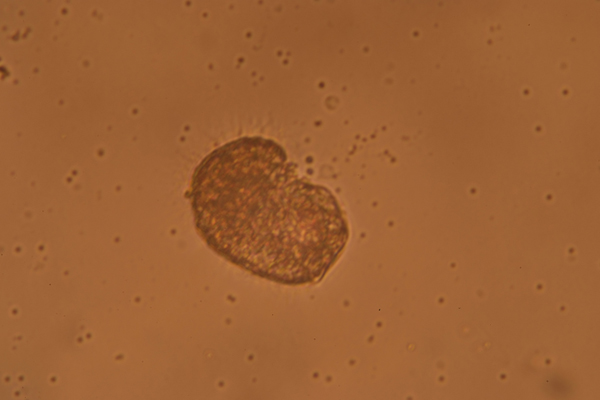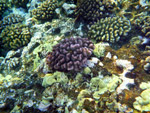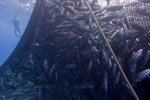Scientists have long known that ocean acidification is leading to a decline in Pacific oyster (Crassostrea gigas) in the U.S.’s Pacific Northwest region, but a new study in the American Geophysical Union shows exactly how the change is undercutting populations of these economically-important molluscs. Caused by carbon dioxide emissions, ocean acidification changes the very chemistry of marine waters by lowering pH levels; this has a number consequences including decreasing the availability of calcium carbonate, which oysters and other molluscs use to build shells.
The scientists found that while ocean acidification in the region was not yet reached the levels where it would begin dissolving adult oyster shells, current levels were making it increasingly difficult for more vulnerable oyster larvae to build their shells.
Pacific oyster begin their lives as free-flowing eggs released from females which are then fertilized by the males. Once fertilization occurs, the oyster transform into shell-free larvae. However, these oyster larvae—which live off the nutrients of their egg for the first few weeks—must rapidly build their shells before attaching themselves to the sea floor. During the shell-building process, the juveniles also develop new feeding parts.
“It becomes a death race of sorts,” explains lead author George Waldbusser with Oregon State University, Corvallis. “Can the oyster build its shell quickly enough to allow its feeding mechanisms to develop before it runs out of energy from the egg?”
But more carbon dioxide in the oceans has made it so that young oysters are increasingly likely to lose this “death race.” Oyster larvae are forced to expend more energy to build their shells. In contrast, adult oysters are capable of continuing to produce shell material once they get through the larvae stage, albeit more slowly than in the past.
“The failure of oyster seed production in Northwest Pacific coastal waters is one of the most graphic examples of ocean acidification effects on important commercial shellfish,” says Dave Garrison, program director with the U.S. National Science Foundation’s (NSF) Division of Ocean Sciences. “This research is among the first to identify the links among organism physiology, ocean carbonate chemistry and oyster seed mortality.”
The news from the research is not all bad however for oyster-eaters. Artificial oyster hatcheries have various means to mitigate the impact of ocean acidification on their clutches, however the same can be said for wild oysters.
While carbon emissions from burning fossil fuels initially enter the atmosphere, a significant percentage is sequestered by the oceans where it has led to acidification. In some places, pH levels have dropped so far that shells have begun to dissolve. Although garnering less attention than global warming, ocean acidification could have devastating impacts on the world marine ecosystems, including decimating coral reefs. Jane Lubchenco, the head of the U.S. National Oceanic and Atmospheric Administration (NOAA), has recently dubbed ocean acidification “climate change’s equally evil twin.” Still, such warnings have not led to success in cutting global carbon emissions, which reached a new record last year according to the International Energy Agency (IEA).
The study was funded by the NSF.

Pacific oyster embryo, seen under a light microscope. Formation of first shell has just begun. Photo by: G. Waldbusser, OSU.
CITATION: Waldbusser, G. G., E. L. Brunner, B. A. Haley, B. Hales, C. J. Langdon, and F. G. Prahl (2013), A developmental and energetic basis linking larval oyster shell formation to acidification sensitivity, Geophys. Res. Lett., 40, doi:10.1002/grl.50449.
Related articles
Pacific islanders are the ‘victims of industrial countries unable to control their carbon dioxide emissions’
(05/15/2013) With islands and atolls scattered across the ocean, the small Pacific island states are among those most exposed to the effects of global warming: increasing acidity and rising sea level, more frequent natural disasters and damage to coral reefs. These micro-states, home to about 10 million people, are already paying for the environmental irresponsibility of the great powers.
Warnings of global ecological tipping points may be overstated

(03/05/2013) There’s little evidence that the Earth is nearing a global ecological tipping point, according to a new Trends in Ecology and Evolution paper that is bound to be controversial. The authors argue that despite numerous warnings that the Earth is headed toward an ecological tipping point due to environmental stressors, such as habitat loss or climate change, it’s unlikely this will occur anytime soon—at least not on land. The paper comes with a number of caveats, including that a global tipping point could occur in marine ecosystems due to ocean acidification from burning fossil fuels. In addition, regional tipping points, such as the Arctic ice melt or the Amazon rainforest drying out, are still of great concern.
Animals dissolving due to carbon emissions

(12/03/2012) Marine snails, also known as sea butterflies, are dissolving in the Southern Seas due to anthropogenic carbon emissions, according to a new study in Nature GeoScience. Scientists have discovered that the snail’s shells are being corroded away as pH levels in the ocean drop due to carbon emissions, a phenomenon known as ocean acidification. The snails in question, Limacina helicina antarctica, play a vital role in the food chain, as prey for plankton, fish, birds, and even whales.
Threatened Galapagos coral may predict the future of reefs worldwide

(11/07/2012) The Galapagos Islands have been famous for a century and a half, but
even Charles Darwin thought the archipelago’s list of living wonders
didn’t include coral reefs. It took until the 1970s before scientists
realized the islands did in fact have coral, but in 1983, the year the
first major report on Galapagos reef formation was published, they
were almost obliterated by El Niño. This summer, a major coral survey
found that some of the islands’ coral communities are showing
promising signs of recovery. Their struggle to survive may tell us
what is in store for the rest of the world, where almost
three-quarters of corals are predicted to suffer long-term damage by
2030.
Coral calcification rates fall 44% on Australia’s Great Barrier Reef
(09/04/2012) Calcification rates by reef-building coral communities on Australia’s Great Barrier Reef have slowed by nearly half over the past 40 years, a sign that the world’s coral reefs are facing a grave range of threats, reports a new study published in the Journal of Geophysical Research – Biogeosciences.
Earth’s ecosystems still soaking up half of human carbon emissions

(08/06/2012) Even as humans emit ever more carbon dioxide into the atmosphere, Earth’s ecosystems are still sequestering about half, according to new research in Nature. The study finds that the planet’s oceans, forests, and other vegetation have stepped into overdrive to deal with the influx of carbon emitted from burning fossil fuels, but notes that this doesn’t come without a price, including the acidification of the oceans.
2,600 scientists: climate change killing the world’s coral reefs

(07/10/2012) In an unprecedented show of concern, 2,600 (and rising) of the world’s top marine scientists have released a Consensus Statement on Climate Change and Coral Reefs that raises alarm bells about the state of the world’s reefs as they are pummeled by rising temperatures and ocean acidification, both caused by greenhouse gas emissions. The statement was released at the 12th International Coral Reef Symposium.
World failing to meet promises on the oceans

(06/14/2012) Despite a slew of past pledges and agreements, the world’s governments have made little to no progress on improving management and conservation in the oceans, according to a new paper in Science. The paper is released just as the world leaders are descending on Rio de Janeiro for Rio+20, or the UN Summit on Sustainable Development, where one of the most watched issues is expected to be ocean policy, in part because the summit is expected to make little headway on other global environmental issues such as climate change and deforestation. But the new Science paper warns that past pledges on marine conservation have moved too slowly or stagnated entirely.
Featured video: Google Earth highlights imperiled coral reefs around the world
(04/18/2012) A new video by Google Earth and the World Resources Institute (WRI) highlights the world’s many endangered coral reefs. A part of the WRI’s Reefs at Risk program, the video highlights regional and global threats to the oceans’ most biodiverse ecosystem. According to the WRI, a stunning 75 percent of the world’s reefs are currently threatened.
Carbon emissions paving way for mass extinction in oceans
(03/05/2012) Human emissions of carbon dioxide may be acidifying the oceans at a rate not seen in 300 million years, according to new research published in Science. The ground-breaking study, which measures for the first time the rate of current acidification compared with other occurrences going back 300 million years, warns that carbon emissions, unchecked, will likely lead to a mass extinction in the world’s oceans. Acidification particularly threatens species dependent on calcium carbonate (a chemical compound that drops as the ocean acidifies) such as coral reefs, marine mollusks, and even some plankton. As these species vanish, thousands of others that depend on them are likely to follow.
Acid oceans: in some regions acidification a ‘hundred times greater’ than natural variation
(01/24/2012) Emissions of carbon over the last two centuries have raised the acidity of the oceans to the highest levels in 21,000 years and likely beyond, according to a new study in Nature Climate Change. The change threatens a number of marine species, including coral reefs and molluscs.